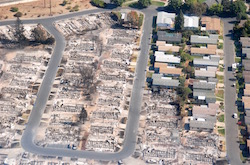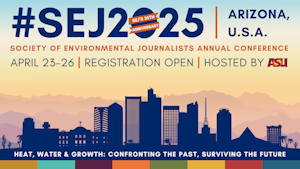SEJournal Online is the digital news magazine of the Society of Environmental Journalists. Learn more about SEJournal Online, including submission, subscription and advertising information.
TipSheet: Wildland-Urban Interface — How Disastrous Wildfires Get Into Your Neighborhood
The wildfires that devastated wine country and other parts of California this October were shocking — but much of the damage could be predicted, with wildfire risk like this mounting as urban (and suburban) development expands into fire-prone wildlands.
It’s this “wildland-urban interface” where many fire disasters happen these days.
Of course, the California fires were worsened by many other factors: winds, fuel buildup (from several causes), dry/hot weather, and even climate change. And some of the incinerated neighborhoods had little real “wildland” to them. Still, the wildland-urban interface, or WUI, was often where the worst tragedies happened.
California’s wine country fires recalled other recent catastrophic WUI fire episodes, such as the May 2016 Fort McMurray fire in Alberta, Canada, that destroyed some 2,400 homes. Or the November 2016 fires near Gatlinburg, Tenn., in the Great Smoky Mountains that killed at least 14.
A complex problem that starts with fire behavior
Environmental reporters may want to remember that WUI fire risks happen in many places. Do they include your community? If so, there are stories to report.
You may find this out locally by using your eyes and ears, looking at maps, driving around, talking to experts, firefighters and neighbors, and checking in with local and state agencies. WUI fire risks may not be significant everywhere — but if you have them, there is some likelihood they are underappreciated.
 |
| An aerial view of the homes burnt to the ground by the wildfires in Santa Rosa, Calif. Photo: Army National Guard/Capt. Will Martin |
Identifying WUI fire risks can lead you to stories not just about fire risk, but also to stories about development, zoning, building codes, construction methods and materials, landscape design, local safety ordinances, disaster preparedness, firefighting resources, roads, water, ecosystems and more.
Most of these stories can best be done before the fire starts. But to do them, you may want to learn a thing or two about fire behavior.
Wildfire does not just happen in forests. It can happen in grassland, shrub/scrub and other kinds of vegetation.
According to a 2005 study, “Some 32 percent of U.S. housing units and one-tenth of all land with housing are situated in the wildland-urban interface.” Your readers love their cozy cabins in the woods? Sometimes WUI structures are in the middle of wildfire zones; sometimes they are on the edge. The interface can extend much farther than you think. Winds or firestorms can blow embers more than a mile. Blizzards of embers, combined with high winds, can burn neighborhoods even when they are mostly free of wildland vegetation.
Covering the WUI story
Here are some useful resources and tips to help report on WUI fires:
- Maps. You can get an overview of the WUI picture nationally from this map published by the Forest Service (see page 11 of the report). An improved and localized version of the same map set, by Stewart and Radeloff, is available here from the University of Wisconsin’s SILVIS lab. Here, for example, is the map for California. The data mapping company ESRI also makes available a set of mapped data on the WUI.
- Construction. Certain building materials are quite flammable. Wood is one. A roof made out of wood shakes is a good bet to catch fire when wind-blown embers land on it. Same with wood decks. Slate, tile or metal roofs are going to resist ignition. Asphalt shingles are in between (check their fire rating). Real fire resistance depends on other factors as well. How well do your local building codes (if any) promote fire resistance?
- Landscaping. Owners of homes and buildings can protect their structures against wildfires, to some extent, by landscaping. This often means removing most vegetation, especially resinous trees, from the immediate vicinity of the house. It also means reducing flammable debris nearby. Woodpiles and propane tanks should be exiled. Keeping nearby vegetation and soil moist is also key. The idea is to create a “defensible space.” Firefighters will appreciate this if they get to a house in time to try to save it. Cal Fire even has an app for that.
- Evacuation Routes and Planning. One horrifying scenario for people fleeing homes in the middle of a wildfire is discovering that the road out is blocked or threatened by wildfire. People in remote areas with only one road out need to heed warnings, evacuate early and plan ahead. Roads are also essential for firefighters to get in. Good water sources near structures are also key. (Some people have survived fires in swimming pools.)
- Local Codes and Standards. You can report on how well your local codes and standards help protect people against wildfire. The U.S. Fire Administration has a “toolkit” on WUI fire protection that includes a substantial section describing protective codes and standards.
- Other Handy Sources. Whenever you are covering wildfire (or wildfire protection), it is good to be aware of some major reliable sources of information. The National Interagency Fire Center is a portal to many authoritative sources. The U.S. Forest Service’s Active Fire Mapping Program may help in a pinch. Wildfire Today is another good source. Check in with your own state forestry and wildfire response agencies, as well as the National Association of State Foresters. An SEJournal backgrounder on wildfires has more sources, as does this recent Tipsheet. Also read a recent Q&A with SEJer Michael Kodas about his new book on the changing nature of fires, as well as an interview with a photojournalist who specializes in shooting wildfires.
* From the weekly news magazine SEJournal Online, Vol. 2, No. 39. Content from each new issue of SEJournal Online is available to the public via the SEJournal Online main page. Subscribe to the e-newsletter here. And see past issues of the SEJournal archived here.














 Advertisement
Advertisement 



